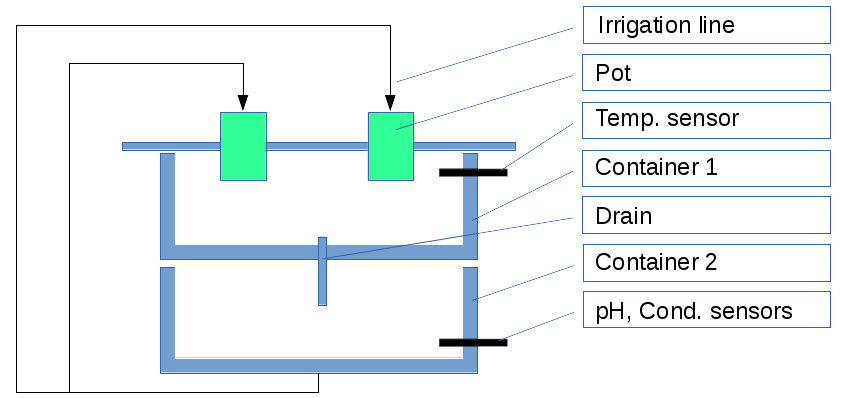Introduction
After several successful pepper-growing experiments, the Capsitron system was employed to cultivate basil (Ocimum sp.), the most popular fresh culinary herb. In this experiment, Chilli Focus liquid fertilizer was utilized in a batch cultivation, wherein the nutrient solution was recirculated. No fresh fertilizer was added during the batch cultivation; only the pH was controlled within the range of 5.8 to 6.2, and evaporated water was replenished. For pH control, potassium hydrogen carbonate and sulfuric acid were used. There was no temperature control, so the internal temperature was mainly determined by the external temperature, particularly in the root zone. However, the LEDs themselves generated heat, resulting in higher temperatures in the shoot region during the daytime.
Materials and methods
A Detailed Look at the Components and Features

Fig 1. Schematic Representation of the Internal Structure of the Lower Unit of Capsitron.
The plant growing device is made up of two main physical units. The first main unit, called Capsitron, contains three subunits: the top, the middle and the lower units. The top unit houses the electronic modules, the minicomputer, the microcontrollers for processing the sensory signals, the RGB LED controller and the LED panel at the bottom of the unit. The middle unit provides the space for the plant material and also serves as a docking station for the second
main unit, the SeedBox. The lower unit contains the nutrient solution tank that supplies the necessary amount of water and nutrients for the plant, and in which the roots have more room to grow. The variables that determine the living conditions of the plant, such as temperature, pH value and conductivity, are measured in the lower unit as well.
The lower unit consists of two 10L polypropylene containers (Eurobox) with dimensions of 400 mm x 300 mm x 120 mm (length x width x height). Container 2 is filled with a nutrient solution, while Container 1 is an empty container with a drain. On top of container 2, there is a 4mm thick PVC cover with rectangular holes for inserting pots. The pots were filled with clay balls, and on top of the clay balls, there was a thick sheet of cotton wool where the seeds were placed. The pots were covered with the SeedBox lid, which shadows the root zone and holds the irrigation tubes. When the seeds germinate, they grow through the middle hole of the SeedBox lid. Two-thirds of the pots extend into the lower unit, and one-third is located in the middle unit together with the SeedBox lid.
Irrigation
Peristaltic pumps deliver the nutrient solution from Container 2 to the pots. All four pumps are controlled individually and are turned on once a day for 2 minutes. Meanwhile, they deliver about 200 mL of solution. Excess water flows out of the pots into Container 1, from where it goes back to Container 2 through the drain.
Varieties, media, growth conditions
Three random seeds were sown per pot. Two different basil varieties, Sweet Basil and Dark Opal Basil, were used, which were previously cultivated close to each other in the landfield, and their seeds were collected together.
7 liters of tap water (refer to the composition in Table 1) were filled into Container 2, and 20 mL of Chilli Focus (refer to the composition in Table 2) was added. The initial pH was 6.6, while the conductivity was 1400 μS/cm.
The temperature was uncontrolled, but the values were measured and registered in the root and shoot regions also. The optimal pH and EC range, 5.8-6.2 and 0.5-1.5 mS/cm [1] respectively, was set manually. A contactless water sensor was applied, and, according to its signal, the evaporated water was replenished manually from time to time.
| Parameter | Concentration [mg/L] |
| Nitrate | 19.3 |
| Ammonium | 0 |
| Chloride | 10 |
| Sulfate | 32 |
| Sodium | 19 |
| Water hardness [CaO] | 195 |
| Name | % |
| Calcium nitrate | ≥ 1 – <3 |
| Ammonium nitrate | ≥1 – <2 |
| Sodium molybdate | <0.005 |
